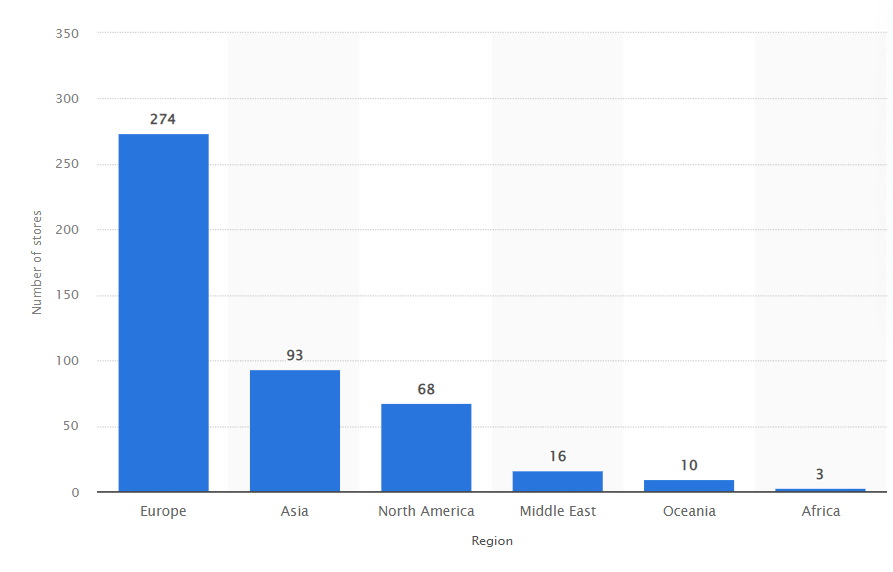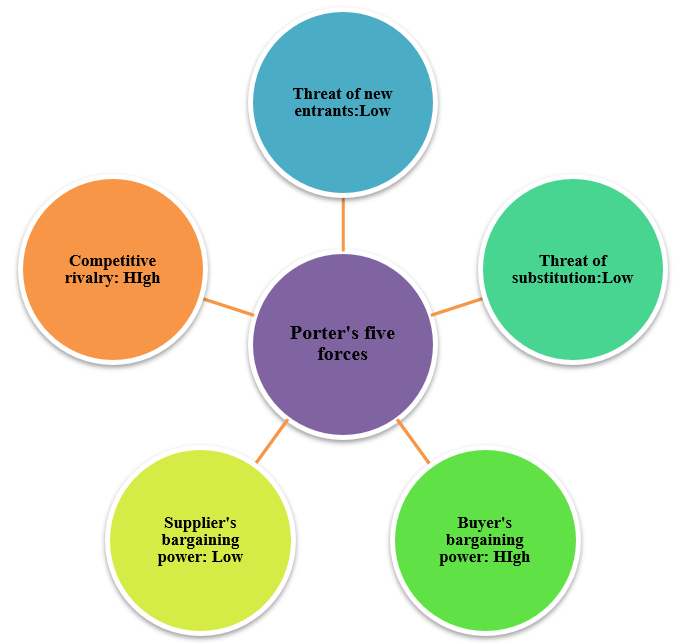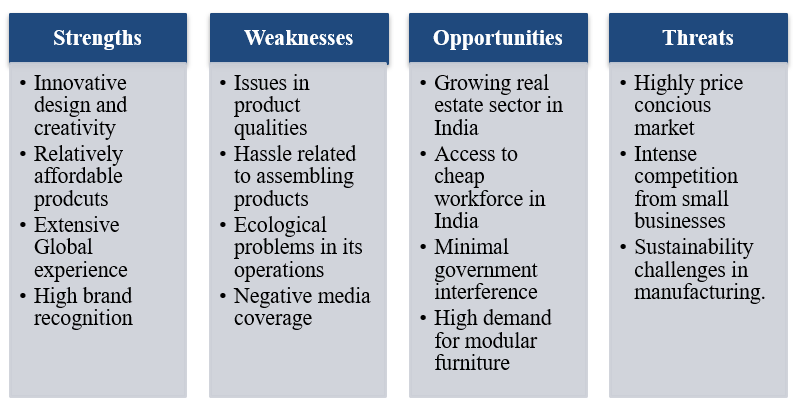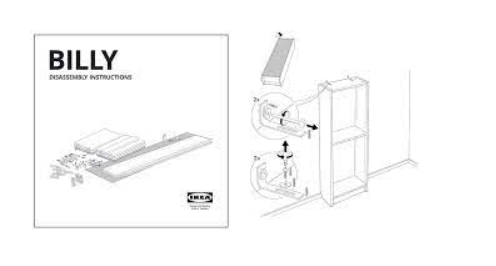Executive summary
IKEA is the world’s leading furniture retailer, distinguished for its relatively affordable modern furniture. It was established by Ingvar Kamprad in 1943 as a small Swedish mail-order directory operation. IKEA features around 360 shops from over 50 nations (IKEA, 2021). IKEA’s strategic analysis is the basis for this study. The micro and macro environmental analysis, as well as the organisational background, have been presented. In addition, the company’s deliberate and emergent strategy in India has been assessed.
The political environment is stable and the demographic characteristics of the market are encouraging as the median age of the population is 28 years. The technological facilities are favourable for the business of IKEA however complex taxation and legal structure can be problematic for the company. Indian buyers are budget conscious and loyal to merchants with whom they have a long-standing connection (Ghosh, 2020). In the furnishings and household appliance business, buyers have a lot of bargaining leverage (Imaya, 2017). The threat of new entrants is minimal however competitive rivalry is high in the country.
IKEA mostly employs intentional strategy in their operations, but they have also demonstrated emergent strategy while reacting to market realities in India. The organisation must continue on this route in order to prosper in the future.
The main recommendation is regarding utilising its vast experience and formulating long-term plans to fulfil the growing demand for modular furniture in the Indian market. IKEA can leverage its global brand image and launch social media promotional campaigns to attract consumers while actively engaging with them.
1. Introduction and company context
Strategic planning is a method through which executives and managers decide their long-term direction along with their organization’s mission and goals. The approach also includes identifying the order in which certain milestones must be attained so that the organisation may realize its specified vision (Nickols, 2016). IKEA’s strategic analysis is the basis for this study. The micro and macro environmental analysis, as well as the organisational background, will be presented. In addition, the company’s deliberate and emergent strategy in India will be assessed. IKEA’s innovations will also be assessed, and recommendations based on the entire analysis will be provided.
IKEA is the world’s leading furniture retailer, distinguished for its relatively affordable modern furniture. It was established by Ingvar Kamprad in 1943 as a small Swedish mail-order directory operation. IKEA features around 360 shops from over 50 nations (IKEA, 2021).

Figure 1: IKEA number of stores by region
(Source: Statista, 2022)
With worldwide revenue of about 28 billion Euros, 2013 constituted a landmark year for profitability. Although Europe accounts for the majority of IKEA’s sales, the organization is trying to spread further beyond other geographic areas in order to obtain even stronger development. While the prospect of over 1 billion clients in India is intriguing, the corporation also should deal with a number of main impediments.
1.1 PESTLE analysis
| Political | ● Local authorities have a substantial impact on policy development and execution.
● The administration is abiding by all of the World Trade Organization’s policies and guidelines (Banga, 2019). ● Both the formulation of policies and their execution are coherent. ● India is ranked 63rd in the world for ease of doing business (World Bank, 2019). |
| Economic | ● Middle-class population is rising
● The entire market is traditionally prices sensitive ● The Purchasing power parity world rank is 128 and 31 in Asia (Statistics Times, 2021). ● The estimated GDP growth rate in 2021-2022 is 8.8% which can be favourable for the business of IKEA (Business Standard, 2022). |
| Social | ● There is good availability of cheap labour
● Due to the impact of worldwide consumer lifestyles, Indian residents are gravitating toward trendy and imported furnishings. ● Self-assembly of the famed flat-pack concepts unsettles Indian consumers. As a result, Ikea has partnered with local craftsmen and transportation providers in India (Martinell, 2020). ● There are 1.3 billion people in the country, with a median age of 28 (Worldometer, 2021). |
| Technological | ● While India has the second-highest number of smartphone users in the world, IKEA has a big opportunity to reach out to Indian clients online (IBEF, 2021).
● There are reputable science and technology institutes, as well as skilled management and manpower. ● The governmental and business sectors are putting a greater emphasis on digitization (Subathra & Selvanathan, 2019). |
| Environmental | ● There is a strong focus on renewable energy sources.
● The air quality has been poor and waste handling and disposal can be an issue for IKEA (IQAIR, 2021). |
| Legal | ● The import duties have been hiked in recent years by the government.
● The legal system is complex and slow and a lengthy period is required to resolve any legal disputes(Fernando & Muralidheeran, 2019). ● This can affect the operations of IKEA in the long run. |
Table 1: PESTLE analysis of India for IKEA
(Source: Created by author utilising different sources)
1.2 Porter’s five forces

Figure 2: Porter’s five forces analysis on IKEA
(Source: Created by author)
Porter’s Five Forces model is strongly influenced by classical microeconomics. In the next section, the five forces that influence IKEA’s market configuration have been assessed using this model. This analysis can aid in recognizing and addressing the kind and amount of competition, as well as how IKEA should deal with it (Bruijl, 2018).
Competition among existing companies: High
Pepperfry, India’s leading furniture company, and numerous domestic companies with an Indian core market, such as Future Group and Home Stop, competes aggressively in the Indian market. Given IKEA’s arrival, the smaller and midsize retail furniture industry may ultimately have a defined configuration (Ehsan Ullah et al., 2016). Other prevailing businesses may not be as extensive as IKEA, but they comprehend Indian consumers fairly well primarily because they have been in the Indian marketplace for a prolonged time. Because of the minimal price of the furniture, preexisting furniture companies have built a solid grip among Indian customers (Yadav, 2020).
The threat of new entrants: Low
New competitors will not be capable to profit from efficiency gains to the same magnitude as IKEA, at particular during the formative phases of activities. As mentioned by McNamara & Descubes (2016) The home furnishing market has a number of participants, the preponderance of them are small businesses. When a particular entrant comes on the market, it will require time, research, and expenses to emerge into a substantial business and capture a larger market presence.
Bargaining power of buyers
In the twenty-first century, buyers in all industry segments have more authority. Aside from global competitiveness, technical advances have driven this shift. The balances have moved in favour of the customers. In the furnishings and household appliance business, buyers have a lot of bargaining leverage (Imaya, 2017).
Indian buyers are budget conscious and loyal to merchants with whom they have a long-standing connection (Ghosh, 2020). Because of the fierce rivalry, there is now a big variety of furniture merchants from whom customers get to choose, all of them provide hassle-free, ready-to-use furnishings.
Supplier’s bargaining power: Low
Even though India has supplied Ikea with fabrics, carpets, and other materials since the 1970s, the nation only constituted 3% of the manufacturer’s worldwide supply stream in 2012. IKEA has always been dependent on India for fabrics, rugs, and carpeting, and the country now has 48 providers (Ghosh, 2020).
Regional producers provide Ikea with carpets, couches, pillows, but also many of their famed Ektorp couches, which are frequently shipped to Ikea outlets in the Gulf and other Asian markets. India’s suppliers supply roughly $400 million worth of commodities to Ikea each year, mostly textiles (IKEA, 2021). The firm has been contemplating other product segments such as mattresses, sofas, and certain other types of products. IKEA has a broad range of suppliers across various regions of the world and overall the bargaining power of the suppliers is low.
Threats of substitute products: Low
IKEA in the Indian market is introducing furniture that is in accordance with current trends. IKEA can relatively successfully match any new trend because of its minimalism of design and technological advances (BBC News, 2022).
IKEA has recently joined the Indian market following exhaustive analysis and offers a wide range of space-saving, modern furniture solutions for Indian buyers at a very moderate price. Therefore the threat of substitutes is low in the Indian market.
1.3 SWOT analysis

Figure 2: SWOT analysis of IKEA
(Source: Created by author)
1.4 Bowman’s strategic clock analysis

Figure 3: Strategy clock of furniture companies in India
(Source: Created by author)
There are various small and medium businesses operating in the Indian market. Among the major competitors of IKEA the Bowman’s strategy clock model is utilised to determine the optimum strategic position of businesses to ensure competitive advantage (Rahaman, 2020). IKEA concentrates only on retailing and producing furnishings. As a result of this policy, the company’s strategy clock has been positioned to the Focused Differentiation category.
The competitor Godrej interio has been following a strategy to ensure perceived added value to the consumers while pepperfry focus on a hybrid strategy for their business (Ghosh, 2020).
1.5 Future key drivers of change
| Future key drivers for IKEA in the Indian market |
| · There is a prominent trend towards utilising VR for product demonstration and IKEA can take leadership regarding this in the Indian market. |
| · Increase in residential and commercial properties necessitates modern and customisable furniture in the Indian market (Ghosh, 2020). |
| · The high number of Smartphone and social media users in India can be leveraged through introducing creative and appealing promotional campaigns. |
| · The rising cost of timber and leather raises the expenditure on furniture manufacturing (Inside IIM, 2019). |
Table 2: Future key drivers of change for IKEA
(Source: Created by author)
1.6 VRIO analysis of IKEA
| Capabilities/Resources | Value | Rarity | Inimitable | Organisation | Competitive advantage |
| Economies of Scale | Yes | Yes | Yes | Yes | A long-term competitive edge |
| Strong focus on innovation | Yes | Yes | No | Temporary competitive advantage that involve continued effort to maintain. | |
| Widespread logistics network across the world (Yu et al., 2016). | Yes | Yes | Yes | Yes | A long-term competitive edge |
| World leading furniture retailer | Yes | Yes | No | Temporary competitive advantage | |
| A total of 458 IKEA stores across different regions (Statista, 2021). | Yes | No | Competitive benefit |
Table 3: VRIO analysis of IKEA
(Source: Created by author)
2. Current strategies of IKEA
2.1 Focusing on affordability
The existing strategy of IKEA has focused on maintaining its organisational strategic direction along with adapting partially to ensure market penetration in India.
A sales strategy oriented on delivering a choice of well-designed and practical household furniture goods, along with decorative items, that are inexpensive to the general consumer is crucial to IKEA’s business model. This argument is expounded on by the firm using different techniques within its product line (Pineda, 2021).

Figure 4: IKEA promotional offer based on affordability strategy
(Source: Cweisbrich, 2014)
IKEA draws on the reconfigurable design of furniture solutions to encourage flexibility, customisation, and combining of furnishings units, realizing the need to enhance consumer selections while respecting the uniqueness of customer tastes.
2.2 Strong worldwide distribution
Locating and leveraging the most productive and economical distribution strategy is certainly part of approaching the group of consumers. Consequently, IKEA’s placing and distribution strategy are primarily focused on worldwide retail activities. It is actively expanding its company in the Indian market because of its excellent supply chain and distribution network.
2.3 Transnational strategy
IKEA implemented a transnational strategy while expanding into Russia, Japan, and followed it in India. When there has been a lot of drive for international integration and a lot of additional stress for local adaptation, the transnational approach is employed. Due to regional diversity between the parent and host countries, it becomes the most expensive strategy to implement (Dumetz, 2020).
3. Deliberate strategies
Business strategy, strategic management, and strategic planning are all terminology used in business to characterize the precise steps a corporation takes to attain its strategic interests. A deliberate strategy is one that is the culmination of a company’s and its administration’s purposeful, deliberate, and disciplined initiatives. As per Stobierski (2020), it is basically derived through a detailed evaluation of information, which includes elements like market growth, segment structure, consumer demands, competitor capabilities and vulnerabilities, and changing technology.
Large organisations or companies that are well-established in their industry mostly use a deliberate strategy. Continuity and steadiness equip them with adequate input and familiarity to plan a long-term policy, as well as assurance in their competence to forecast that far ahead as mentioned by Hernández-Betancur, Montoya-Restrepo & Montoya-Restrepo (2019).
IKEA had a proper roadmap for entering India, given 100 per cent foreign direct investment (FDI) permissible in single-brand retailing, and it didn’t desire to execute it through a strategic alliance. The development and quick expansion of e-commerce create even more motivation for IKEA to recognize India as a potential market. Moreover, IKEA should compromise on pricing policy, but on the other side, this should gain from the availability of low-cost, skilled labour (Ghosh, 2020).
After being rescheduled twice, IKEA’s first Indian site started operations in Hyderabad on August 9th, 2018. The 4-story showroom in HITEC city, which included 7,500 well-researched goods (thousand of which are priced for less than $200), has been a major economic disruptor for the Indian retailing sector in principle (Goel & Garg, 2018). Moreover, the Indian furniture retail commercial segment in general. While an IKEA store in Telangana was widely embraced, the CEO, Peter Betzel, faced a number of hurdles, such as labelling requirements, taxation, IPRs, capable of understanding Indian buyers, and, most pertinently, how established rival companies would prepare their strategy to compete with the entry of IKEA (Inside IIM, 2019).
The abovementioned initiatives taken by IKEA to enter the Indian market have been based on extensive research of the key factors of the Indian market. The consumer demands and market dynamics have been evaluated to develop a long term strategy aiming for growth and expansion in the furniture industry of India.
Advantages
- It gives the organisation a specific pathway that all workers can adopt, and it encourages organizational cooperation.
- Having everyone working toward the same interests may make situations a lot easier. It may be simpler to explain demands and expected outcomes since the approach is deliberate and firms spend the effort to design their workarounds (Phillips & Moutinho, 2018).
- Data is needed to facilitate company goals and choices in deliberate initiatives. Organizations may accurately forecast the implications of their activities using modern, data-driven techniques (Setiawan et al., 2019).
Limitations
- The downsides of a planned strategy include the complexity of changing fast when the industry fluctuates and the emphasis on higher leadership to define goals and implement strategies (Stobierski, 2020).
- Even if the external environmental factors in the Indian market are consistent, IKEA may face difficulties if any important element changes dramatically in a short period of time.
4. Emergent strategies
Organizations can implement an emergent strategy to strategize for the near term, although there are a few considerable variations between emergent strategy and deliberate strategy. The former is more flexible and dynamic than a deliberate strategy, which is methodically formed and prepared for long-term application. Emergent solutions, which arise from market trends and action, could be imaginative and productive. Various partners, analysis techniques, and executive leadership are involved in deliberate plans, but emergent strategies are generally the result of subjective views from mid-level administrators or key personnel.
Extensive industry research suggested that Indian buyers seemed unlikely to want to assemble their own furniture, thus IKEA’s first storefront employs 150 full-time workers who assemble cabinets, furniture, and beds for buyers to bring home (IKEA, 2021). Due to the obvious cheap wages in India, it is unrealistic for customers to contribute their own time to manufacturing the items, thus IKEA has changed its strategy (Retail Management, 2018). This suggests that IKEA’s activities in India have used emergent strategies. Certain market drivers were identified in the Indian market, and the management adjusted its strategies to fit the wants of the customers.
In addition, the organization is altering its product ranges. IKEA built a redesigned dining table that promotes Indian consumers’ desire to utilise the furniture not merely as spaces to eat meals but additionally as prominent meeting places for socialising, based on considerable market research. Given the size of the Indian market, such modifications appear to be appropriate adjustments (Retail Management, 2018).
Advantages
- IKEA may devote its resources to mechanisms that are more efficient than their planned efforts by implementing emergent methods.
- IKEA can evolve from the approach and its outcomes using an emerging strategy (Neugebauer, Figge & Hahn, 2016).
- It provides greater flexibility to react to the market dynamics and undertake steps to manage the business.
5. Innovations of IKEA
IKEA has always placed a premium on innovation. IKEA designer Gillis Lundgren devised flat-pack furnishings after he ripped the legs off a table to accommodate his vehicle. The firm then turned its attention to self-assembly items (Ye, 2021). The corporation was able to maintain production costs low by delegating the work to the partners. The appearance of the stores could be totally reevaluated if the majority of IKEA furniture had been offered flat-packed. This ushered in the emergence of warehouse-style businesses in outlying areas (Frearson, 2018). Buyers could complete a pre-determined course around a showroom to ensure they viewed everything, then immediately collect the things from the storage facility and take them to their home.
IKEA’s leadership are determined to take the company to transcend its current strategy and promote the franchise’s and overall firm’s sustainable growth. They are in charge of IKEA’s daily administration, decision-making, and the development of fundamental business structures. Previously, some disputed IKEA’s quality standards. Consumers had no means of knowing what the products were constructed of or even what they appeared like. The strategic storefront for IKEA was built downtown (Danziger, 2020). It is planned and built in such a method that everyone can stroll around the entire place. Customers may now visit a neatly constructed store to observe the furniture and develop graphics for their desirable bedrooms while strolling over.

Figure 5: Furniture of IKEA which can be disassembled
(Source: Jakesong, 2021)
IKEA did not become whatever it is presently just attributable to innovation. Ikea’s customer support is offered 365 days yearly, includes free layout advice, and even has children’s play areas. IKEA delivers an outstanding customer experience and ensures that its customers are satisfied (Stackpole, 2021). Hex wrenches have been the most popular tools used in the assembly of IKEA furniture. IKEA distributes 80 per cent of the responsibility associated with furniture selling to a client. As a result, consumers obtain furniture and assemble them themselves at residence (Jakesong, 2021). Moreover, the technology extends the factory line into the dining area, enabling the advantage of making a buyer strengthen his or her love for furnishings by physically installing it. IKEA’s management may gradually apply this strategy in the Indian market to open up future business opportunities.
6. Conclusion
IKEA has risen to prominence in the furniture sector as a result of its ongoing innovations throughout the world. It can be a beneficial factor for the business in a market such as India, where the population is quickly enticed by prominent global companies in consumer items and retailing.
Due to cultural differences and a high degree of competitiveness and buyer power, the organisation confronts obstacles. IKEA mostly employs intentional strategy in their operations, but they have also demonstrated emergent strategy while reacting to market realities in India. The organisation must continue on this route in order to prosper in the future.
7. Discussion and recommendations
IKEA has undertaken extensive market research to prepare a long term strategy and establish its position in the Indian furniture market. Despite the strong competition, there is substantial potential for business development in the Indian market. Rapid industrialization in India, along with an increasing preference for customizable and lightweight furniture, is anticipated to boost the furniture market’s expansion in the immediate period. Meanwhile, expanding urbanisation in Indian states like Gujarat, Maharashtra, and Tamil Nadu is bolstering the residential society lifestyle (Inside IIM, 2019). Additionally, the Indian corporate sphere is leading to the growth of the government’s attempts at making it easier to execute the trade. These elements are expected to promote the progress of the Indian furniture sector, perhaps presenting IKEA with a lucrative business opportunity.
Furthermore, India’s growing residential construction sector is expected to enhance the consumption of furniture pieces in India’s cities. Aside from that, increased retail expenditure by governmental and non-governmental entities is obliged to encourage the evolution of the Indian furniture industry. Technological innovations including the availability of high-speed internet as with 4G and also the widespread use of smart devices are supporting India’s e-commerce business (TSS, 2020). As a result of these improvements, demand for furniture is increasing, and IKEA management must use its worldwide knowledge to create and match customer desires through a planned approach.
Moreover, the management also needs to observe the market response and restructure some of their operational and marketing activities in the country. There is a requirement of improving their mobile application to provide a convenient experience to the buyers.
References
Banga, R. (2019). Is India Digitally Prepared for International Trade?. Economic and Political Weekly, 54(5), 2. http://164.100.47.193/fileupload/current/115173.pdf
BBC News. (2022). How Ikea tweaked its products to woo India’s shoppers. BBC News. https://www.bbc.com/news/world-asia-india-60256867
Bruijl, G. H. T. (2018). The relevance of Porter’s five forces in today’s innovative and changing business environment. Available at SSRN 3192207. https://www.researchgate.net/profile/Gerard-Bruijl/publication/326026986_The_Relevance_of_Porter%27s_Five_Forces_in_Today%27s_Innovative_and_Changing_Business_Environment/links/5c14165c299bf139c7593f03/The-Relevance-of-Porters-Five-Forces-in-Todays-Innovative-and-Changing-Business-Environment.pdf
Business Standard. (2022, February 28). India’s GDP growth slows to 5.4% in Q3, estimated to rise 8.9% in FY22. Business Standard India. https://www.business-standard.com/article/economy-policy/india-s-gdp-grows-5-4-in-q3-estimated-to-rise-8-9-in-fy22-122022801077_1.html#:~:text=January%2031%2C%202022.-
Cweisbrich. (2014, February 14). Ikea’s Valentines Day Take Over. Loyola Digital Advertising [로욜라 디지털 광고]. https://loyoladigitaladvertising.wordpress.com/2014/02/14/ikeas-valentines-day-take-over/
Danziger, P. N. (2020). Ikea Imagines The Connected Home Of The Future With Innovation Design Lab Space10. Forbes. https://www.forbes.com/sites/pamdanziger/2020/07/11/ikea-imagines-the-connected-home-of-the-future-with-innovation-design-lab-space10/
Dumetz, J. (2020). Too Much Culturally Aware? When Intercultural Reconciliation Fails in Business: The Case of IKEA in Saudi Arabia. Würzburg International Business Forum International Business Conference 2020 Conference Proceedings. https://www.academia.edu/44701764/Too_Much_Culturally_Aware_When_Intercultural_Reconciliation_Fails_in_Business_The_Case_of_IKEA_in_Saudi_Arabia
Ehsan Ullah, E., Karlsson, B., & Dada Olanrewaju, D. (2016). Foreign Market Entry Strategies.: A Case study of IKEA entering the Indian Market. https://www.diva-portal.org/smash/get/diva2:942136/FULLTEXT01.pdf
Fernando, A. C., & Muralidheeran, K. P. (2019). Business Ethics: An Indian Perspective, 3e. Pearson Education India. https://books.google.com/books?hl=en&lr=&id=sjXADwAAQBAJ&oi=fnd&pg=PP1&dq=indian+legal+system+and+business&ots=hkhC9YNRXg&sig=-B4_jhMgEeNcGj2jNF9F2kc-qWQ
Frearson, A. (2018, January 31). 10 game-changing ideas and innovations from IKEA. Dezeen; Dezeen. https://www.dezeen.com/2018/01/31/10-game-changing-ideas-innovations-ikea-ingvar-kamprad/
Ghosh, S. (2020). SEMINAR PAPER IKEA Business Strategy in India. ResearchGate. Retrieved March 30, 2022, from https://www.researchgate.net/publication/340001625_SEMINAR_PAPER_IKEA_Business_Strategy_in_India?enrichId=rgreq-5a02b0ef1ecdc7fda2a25f8d67bd5379-XXX&enrichSource=Y292ZXJQYWdlOzM0MDAwMTYyNTtBUzo4NzA0MTY1ODc0MzE5MzhAMTU4NDUzNDg5NDM5OQ%3D%3D&el=1_x_2&_esc=publicationCoverPdf
Goel, R., & Garg, S. (2018). India as a Marketplace: A Case Study of IKEA. Available at SSRN 3282924. https://papers.ssrn.com/sol3/papers.cfm?abstract_id=3282924
Hernández-Betancur, J., Montoya-Restrepo, L. A., & Montoya-Restrepo, I. (2019). Deliberate strategy deconstructing event for the arising of the emergent strategy. Journal of Engineering and Applied Sciences, 14(22), 8452-8463. https://www.researchgate.net/profile/Juan-Esteban-Hernandez-Betancur/publication/335327164_Deliberate_strategy_deconstructing_event_for_the_arising_of_the_emergent_strategy/links/5d5ea48892851c3763724afb/Deliberate-strategy-deconstructing-event-for-the-arising-of-the-emergent-strategy.pdf
IBEF. (2021). Indian Smartphone Market Reach 173 Million Units In 2021 | IBEF. Www.ibef.org. https://www.ibef.org/blogs/indian-smartphone-market-to-reach-a-record-173-million-units-in-2021
IKEA. (2021). Made in India products. Www.ikea.com. Retrieved March 30, 2022, from https://www.ikea.com/in/en/campaigns/committed-to-india-pub4647380b
Imaya, M. G. (2017). Marketing of the wooden furniture industry in India. Aayvagam Int J Multidiscip Res, 5, 94-96. http://aayvagam.journal.thamizhagam.net/issues/2017/Feb%202017%205/19%20Article%20Feb%202017%205.pdf
Inside IIM. (2019, August 13). Deconstructing Ikea’s India Strategy | Case Study | Powered By ABGLP. InsideIIM. https://insideiim.com/deconstructing-ikeas-india-strategy-case-study-powered-by-abglp
IQAIR. (2021). India Air Quality Index (AQI) and Air Pollution information | AirVisual. (n.d.). Www.iqair.com. https://www.iqair.com/in-en/india
Jakesong. (2021, October 29). IKEA, the most innovative company. Medium. https://medium.com/@jakesong22/ikea-the-most-innovative-company-2b66d7e83f81
Martinell, L. (2020, May 26). IKEA expands into India. ResearchGate; unknown. https://www.researchgate.net/publication/346471184_IKEA_expands_into_India?enrichId=rgreq-9bccf7be6fa2a012b83fa89294985b48-XXX&enrichSource=Y292ZXJQYWdlOzM0NjQ3MTE4NDtBUzo5NjMzMzc5MTk2NzIzMjFAMTYwNjY4OTA2NjUxOQ%3D%3D&el=1_x_2&_esc=publicationCoverPdf
McNamara, T., & Descubes, I. (2016). Can IKEA adapt its service experience to India?. Emerald Emerging Markets Case Studies. https://www.emerald.com/insight/content/doi/10.1108/EEMCS-10-2014-0245/full/html
Neugebauer, F., Figge, F., & Hahn, T. (2016). Planned or emergent strategy making? Exploring the formation of corporate sustainability strategies. Business strategy and the environment, 25(5), 323-336. https://edisciplinas.usp.br/pluginfile.php/5063409/mod_resource/content/2/BSE25i5Planned-Emergent%20Strategy_SustainabilityStrategies_Neugebauer_et_al-2016.pdf
Nickols, F. (2016). Strategy, strategic management, strategic planning and strategic thinking. Management Journal, 1(1), 4-7. https://nickols.us/~nickols1/strategy_etc.pdf
Phillips, P., & Moutinho, L. (2018). Strategy. In Contemporary Issues in Strategic Management (pp. 25-45). Routledge. https://www.taylorfrancis.com/chapters/edit/10.4324/9781315674827-2/strategy-paul-phillips-luiz-moutinho
Pineda, M. E. (2021, July 15). The Business Strategy of IKEA: A Discussion. Profolus. https://www.profolus.com/topics/the-business-strategy-of-ikea-a-discussion/
Rahaman, M. (2020, August 24). Porter’s Generic Strategies And Ikea Business Model. Medium. https://immortal-ideas.medium.com/porters-generic-strategies-and-ikea-business-model-bbc254466ce8
Retail Management. (2018, September 27). IKEA’s Strategy in India: If We Build It, They Will Come. Retailing Management. https://www.theretailingmanagement.com/?p=1860
Setiawan, A. S., Rahmawati, R., Djuminah, D., & Widagdo, A. K. (2019). Owner power, deliberate strategy formulation, and strategic management accounting. Opcion, 35(89), 254-270. http://eprints.ukmc.ac.id/3107/2/Opcion%20Vol%2035%20%2889%29%202019_Antonius.pdf
Stackpole, T. (2021, June 4). Inside IKEA’s Digital Transformation. Harvard Business Review. https://hbr.org/2021/06/inside-ikeas-digital-transformation
Statista. (2022). Number of stores of the IKEA Group worldwide 2019, by region. Statista; Statista. https://www.statista.com/statistics/241821/number-of-stores-of-the-ikea-group-worldwide-by-region/
Statistics Times. (2021). India GDP per capita 2020 – StatisticsTimes.com. https://statisticstimes.com/economy/country/india-gdp-per-capita.php
Stobierski, T. (2020, November 19). Emergent vs. Deliberate Strategy: How & When to Use Each. Business Insights – Blog. https://online.hbs.edu/blog/post/emergent-vs-deliberate-strategy
Subathra, C., & Selvanathan, S. (2019). Digitalisation in India. https://www.capeforumyoutrust.org/assets/Publications-pdf/DIGITALISATION%20IN%20INDIA%20%20-%20Jul%202019.pdf
TSS. (2020, September 9). Ikea Market Entry strategy in India. TheStrategyStory. https://thestrategystory.com/2020/09/09/ikea-market-entry-strategy-in-india/
World Bank. (2019). Ease of doing business rank (1=most business-friendly regulations) – India | Data. Data.worldbank.org. https://data.worldbank.org/indicator/IC.BUS.EASE.XQ?locations=IN
Worldometer. (2021). India Population (2022) – Worldometer. Www.worldometers.info. https://www.worldometers.info/world-population/india-population/#:~:text=The%20median%20age%20in%20India%20is%2028.4%20years.
Yadav, N. (2020). IKEA Inc.: the India way. Emerald Emerging Markets Case Studies. https://www.emerald.com/insight/content/doi/10.1108/EEMCS-05-2019-0098/full/html
Ye, C. (2021). IKEA’s Global Sourcing Challenge. Academic Journal of Business & Management, 3(7). https://francis-press.com/uploads/papers/trWpLGH9o8Yp1IstoYZRbOUAFW3HTwMZMeZ0EdW4.pdf
Yu, Y., Wang, X., Zhong, R. Y., & Huang, G. Q. (2016). E-commerce logistics in supply chain management: Practice perspective. Procedia Cirp, 52, 179-185. https://www.sciencedirect.com/science/article/pii/S2212827116308447/pdf?md5=6a27c704ac0c42f22ad076497467e047&pid=1-s2.0-S2212827116308447-main.pdf&_valck=1
 write
write